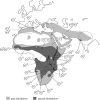The origin, current diversity and future conservation of the modern lion (Panthera leo)
- PMID: 16901830
- PMCID: PMC1635511
- DOI: 10.1098/rspb.2006.3555
The origin, current diversity and future conservation of the modern lion (Panthera leo)
Abstract
Understanding the phylogeographic processes affecting endangered species is crucial both to interpreting their evolutionary history and to the establishment of conservation strategies. Lions provide a key opportunity to explore such processes; however, a lack of genetic diversity and shortage of suitable samples has until now hindered such investigation. We used mitochondrial control region DNA (mtDNA) sequences to investigate the phylogeographic history of modern lions, using samples from across their entire range. We find the sub-Saharan African lions are basal among modern lions, supporting a single African origin model of modern lion evolution, equivalent to the 'recent African origin' model of modern human evolution. We also find the greatest variety of mtDNA haplotypes in the centre of Africa, which may be due to the distribution of physical barriers and continental-scale habitat changes caused by Pleistocene glacial oscillations. Our results suggest that the modern lion may currently consist of three geographic populations on the basis of their recent evolutionary history: North African-Asian, southern African and middle African. Future conservation strategies should take these evolutionary subdivisions into consideration.
Figures



References
-
- Alpers D.L, van Vuuren J, Arctander P, Robinson T.J. Population genetics of the roan antelope (Hippotragus equinus) with suggestions for conservation. Mol. Ecol. 2004;13:1771–1784. doi:10.1111/j.1365-294X.2004.02204.x - DOI - PubMed
-
- Arctander P, Johansen C, Coutellec-Vreto M. Phylogeography of three closely related African bovids (tribe Alcelaphini) Mol. Biol. Evol. 1999;16:1724–1739. - PubMed
-
- Bandelt H.J, Forster P, Rohl A. Median-joining networks for inferring intraspecific phylogenies. Mol. Biol. Evol. 1999;16:37–48. - PubMed
-
- Barnett, R., Yamaguchi, N., Barnes, I. & Cooper. A. 2006 Lost populations and preserving genetic diversity in the lion Panthera leo: implications for its ex situ conservation. Conserv. Genet Available online 1 March, 2006.
-
- Bauer H, Van Der Merwe S. The African lion database. Cat News. 2002;36:41–53.
Publication types
MeSH terms
Substances
Associated data
- Actions
- Actions
- Actions
- Actions
- Actions
- Actions
- Actions
- Actions
- Actions
- Actions
- Actions
- Actions
- Actions
- Actions
- Actions
- Actions
- Actions
Grants and funding
LinkOut - more resources
Full Text Sources
